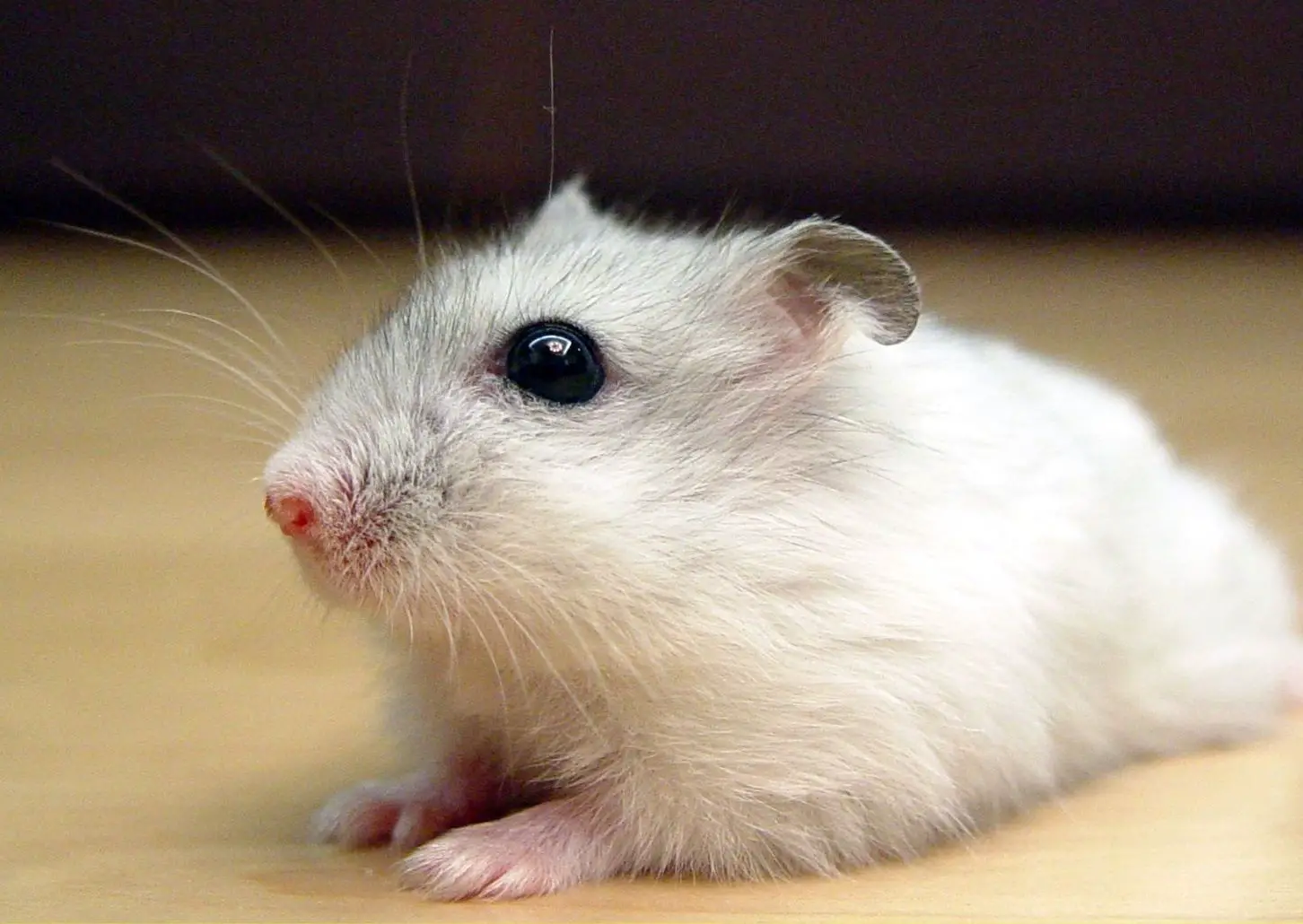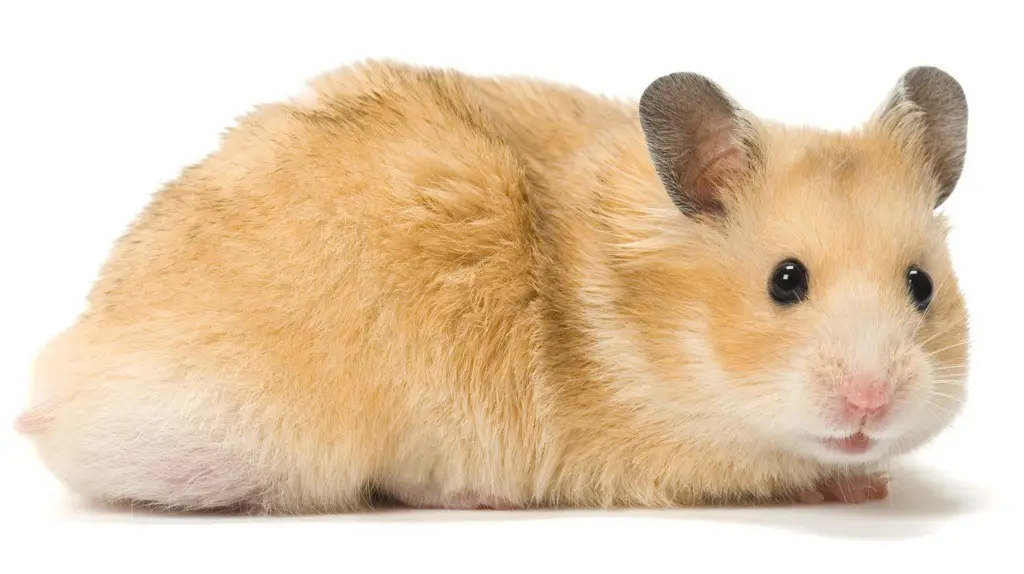The Chinese Hamster is a species of hamster, scientific name Cricetulus griseus, which originate in the deserts of northern China and Mongolia. Chinese hamsters grow to between 7.5 and 9 centimetres in length and as adults can weight 50 – 75 grams. Chinese Hamsters live two to three years on average.
A Chinese hamsters body proportions, compared with those of other hamsters, appear ‘long and thin’ and they have (for a hamster) a relatively long tail. Chinese hamsters are not, technically, ‘dwarf’ hamsters since this term refers to animals in the genus Phodopus, (the two types of Russian Dwarf Hamsters and Roborovskii Dwarf Hamsters).
The wild colour is greyish brown above with a black stripe down the spine and a whitish belly. This colouration, combined with their nimble build and longer tail, makes them look ‘mousy’ and in fact, they are members of the group called ratlike hamsters. Besides the wild colour, a well-known variation is the white-spotted Chinese hamster, which often is greyish white all over, with only a dark stripe on its back.
Chinese hamsters have quiet temperaments and are easily handled. One of their endearing traits is that of clinging to a finger with all four paws, rather like a harvest mouse on a corn stalk. Chinese hamsters can be quite nervous as youngsters, however, once they are tame, display an endearing calmness and gentleness of character.
In common with other small rodents, Chinese hamsters have poor eye-sight, however, they have acute senses of smell and hearing.
CHINESE HAMSTER BEHAVIOUR
In its natural habitat the Chinese Hamster lives in burrows which it excavates itself. Some burrows have a single entrance hole while others have two or even three entrances.
The complex burrows with multi-entrances are most likely to be the domain of experienced, mature animal and it is probably younger individuals that are responsible for the simpler burrows.
Within the larger burrows one finds the main living quarters and separate chambers for food storage and nesting. Although Chinese Hamsters are fiercely territorial, these burrows are often found very close to each other, giving the misleading impression of them living in colonies.
Chinese Hamsters possess enormous internal cheek pouches. Chinese Hamsters collect huge quantities of food in their pouches, to transfer to their burrows to consume in relative safety. Chinese Hamsters are excellent climbers, using their slightly prehensile tail as an aid, although in most conventional cages they have little scope to demonstrate their arboreal skills.
CHINESE HAMSTERS IN THE WILD
In the wild, Chinese Hamsters do not hibernate continuously but awaken from time to time to eat stored food. As the weather becomes colder, Chinese Hamsters enter into deep-sleep and the intervals between spells of waking become longer.
CHINESE HAMSTERS IN CAPTIVITY
In captivity, as long as the cage is kept in a warm room, there is no reason why your hamster(s) should attempt to hibernate. If the room temperature drops too low, it may fall into a torpor-like state and may even appear to be dead. On no account should you allow this to happen.
- The Chinese hamster is not technically a dwarf hamster, but is often referred to as the Chinese dwarf hamster due to its small size.
- It belongs to a group known as rat-like hamsters, because it has a long slender body, triangular-shaped head and short but noticeable tail. The short, less mouse- or rat-like head is favored by hamster breeders. The ideal shape is an equilateral triangle formed by the nose and ears.
- Although the Chinese hamster has long been accepted as being Cricetulus griseus both within laboratories and within the hamster fancy, there is some debate as to whether the Chinese hamster is actually C. barabensis.
- A Chinese hamster lives on average two to three years and is not particularly prone to any illness.
- Chinese hamsters are 4 to 5 inches in length with a 1/2- to 1-inch tail.
- Male Chinese hamsters are larger than the female Chinese hamsters. The males are easily identified by a large scrotal sac.
- The longer tail and shorter fur of the Chinese hamster combine to make the tail more noticeable on this species than the other pet hamsters. The Chinese hamster uses its tail to balance when climbing and also to wrap around objects for extra grip.
- Chinese hamsters have an amazing ability to grip using their feet, body and tail, often wrapping themselves around and clinging to their handlers’ fingers. The Chinese hamster owner would have to gently pry off the hamster to place it back into the cage.
- The Chinese hamster is very timid and fast, often displaying short bursts of activity and speed, which can make it difficult to catch. The Chinese hamster’s timid nature also means that when it is handled, it tends to sit still. They are far more timid than the other hamster species and spend shorter periods out in the open while in the cage than the other hamster species, particularly at first. The Chinese hamster will quickly dart into the nearest hiding place when it hears a strange noise, whereas the other hamster species may be curious and inquisitive, although still on the alert for danger.
- Chinese hamsters have an unfortunate tendency to empty their bladders while being handled — unless they are familiar and comfortable with the handler.
- The normal coloring of the Chinese hamster is dark brown on the head and back with a black stripe running along the spine and tail, and an off-white belly. One pattern mutation, the dominant spot, produces a Chinese hamster with a pure-white belly and white patterning or spots across the back. Occasionally dominant spot hamsters occur where the hamster is completely white; these are rare and have a tendency to be small and weak.
- In some U.S. states, such as California, only Syrian hamsters and the dwarf hamsters are allowed to be kept as pets. Unfortunately, the Chinese hamster does not belong to the genus Phodopus and is therefore a restricted animal or illegal. A permit is required from the state’s Department of Fish and Game to keep or transport Chinese hamsters within these states. Such permits are usually only granted to licensed exhibitors or research laboratories. Contact your state’s Department of Fish and Game to find out if the Chinese hamster is legal where you live.





